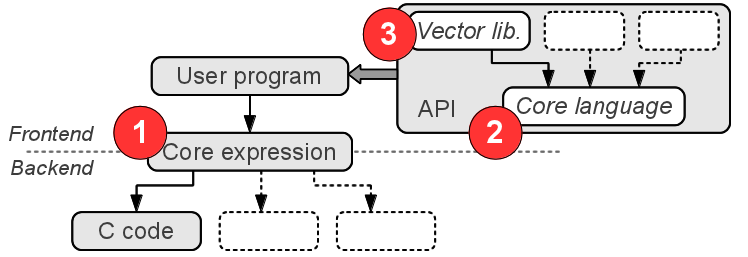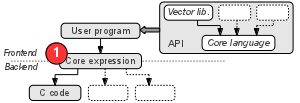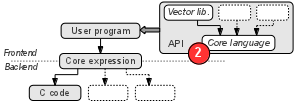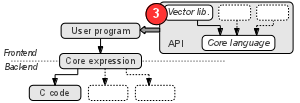Architecture

Emil Axelsson
AFP guest lecture, March 2013
Feldspar was initiated by Ericsson and Chalmers with the aim to improve development of signal processing software
Why?
Performance and portability essential
But
And
ANSI-C specification:
for (j = 0; j < L_frame; j++, p++, p1++)
{
t0 = L_mac (t0, *p, *p1);
}
corr[i] = t0;Equivalent loop optimized for specific processor:
#pragma MUST_ITERATE(80,160,80);
for (j = 0; j < L_frame; j++)
{
pj_pj = _pack2 (p[j], p[j]);
p0_p1 = _mem4_const(&p0[j+0]);
prod0_prod1 = _smpy2 (pj_pj, p0_p1);
t0 = _sadd (t0, _hi (prod0_prod1));
t1 = _sadd (t1, _lo (prod0_prod1));
p2_p3 = _mem4_const(&p0[j+2]);
prod0_prod1 = _smpy2 (pj_pj, p2_p3);
t2 = _sadd (t2, _hi (prod0_prod1));
t3 = _sadd (t3, _lo (prod0_prod1));
p4_p5 = _mem4_const(&p0[j+4]);
prod0_prod1 = _smpy2 (pj_pj, p4_p5);
t4 = _sadd (t4, _hi (prod0_prod1));
t5 = _sadd (t5, _lo (prod0_prod1));
p6_p7 = _mem4_const(&p0[j+6]);
prod0_prod1 = _smpy2 (pj_pj, p6_p7);
t6 = _sadd (t6, _hi (prod0_prod1));
t7 = _sadd (t7, _lo (prod0_prod1));
}
corr[i] = t0; corr[i+1] = t1;
corr[i+2] = t2; corr[i+3] = t3;
corr[i+4] = t4; corr[i+5] = t5;
corr[i+6] = t6; corr[i+7] = t7;Hand-optimized version probably not suited for a different processor; non-portable!
#pragma MUST_ITERATE(80,160,80);
for (j = 0; j < L_frame; j++)
{
pj_pj = _pack2 (p[j], p[j]);
p0_p1 = _mem4_const(&p0[j+0]);
prod0_prod1 = _smpy2 (pj_pj, p0_p1);
t0 = _sadd (t0, _hi (prod0_prod1));
t1 = _sadd (t1, _lo (prod0_prod1));
p2_p3 = _mem4_const(&p0[j+2]);
prod0_prod1 = _smpy2 (pj_pj, p2_p3);
t2 = _sadd (t2, _hi (prod0_prod1));
t3 = _sadd (t3, _lo (prod0_prod1));
p4_p5 = _mem4_const(&p0[j+4]);
prod0_prod1 = _smpy2 (pj_pj, p4_p5);
t4 = _sadd (t4, _hi (prod0_prod1));
t5 = _sadd (t5, _lo (prod0_prod1));
p6_p7 = _mem4_const(&p0[j+6]);
prod0_prod1 = _smpy2 (pj_pj, p6_p7);
t6 = _sadd (t6, _hi (prod0_prod1));
t7 = _sadd (t7, _lo (prod0_prod1));
}
corr[i] = t0; corr[i+1] = t1;
corr[i+2] = t2; corr[i+3] = t3;
corr[i+4] = t4; corr[i+5] = t5;
corr[i+6] = t6; corr[i+7] = t7;(Old) Idea: Separate algorithm from optimizations
Fast and portable code!
High-level DSL for numeric processing
Embedded in Haskell
More info on embedding: [Hudak1998, Elliott2003]
Language front-end:
Back-ends:
File header:
import qualified Prelude as P
import Feldspar -- Core language
import Feldspar.Vector -- List-like data structure
import Feldspar.Compiler -- C code generatortype Point = (Data Float, Data Float)
dist :: Point -> Point -> Data Float
dist (x1,y1) (x2,y2) = sqrt (square (x1-x2) + square (y1-y2))
where
square x = x*xData gives the same definition in ordinary Haskell(Data is the AST of Feldspar expressions.)
Interactive evaluation:
*Main> eval dist (5,10) (8,6)
5.0Compilation:
*Main> icompile dist
...
void test(struct s_float_float_ * v0, struct s_float_float_ * v1, float * out)
{
float v2;
float v3;
v2 = ((* v0).member1 - (* v1).member1);
v3 = ((* v0).member2 - (* v1).member2);
(* out) = sqrtf(((v2 * v2) + (v3 * v3)));
}Typical DSP operations
Exercise: Express as Haskell functions
elemMult :: [Float] -> [Float] -> [Float]
movingAvg :: [Float] -> [Float]
sProd :: [Float] -> [Float] -> FloatHaskell:
elemMult :: [Float] -> [Float] -> [Float]
movingAvg :: [Float] -> [Float]
sProd :: [Float] -> [Float] -> Float
elemMult as bs =
movingAvg as =
sProd as bs =Haskell:
elemMult :: [Float] -> [Float] -> [Float]
movingAvg :: [Float] -> [Float]
sProd :: [Float] -> [Float] -> Float
elemMult as bs = zipWith (*) as bs
movingAvg as =
sProd as bs =Haskell:
elemMult :: [Float] -> [Float] -> [Float]
movingAvg :: [Float] -> [Float]
sProd :: [Float] -> [Float] -> Float
elemMult as bs = zipWith (*) as bs
movingAvg as = zipWith (\a a' -> (a+a')/2) (tail as) as
sProd as bs =Haskell:
elemMult :: [Float] -> [Float] -> [Float]
movingAvg :: [Float] -> [Float]
sProd :: [Float] -> [Float] -> Float
elemMult as bs = zipWith (*) as bs
movingAvg as = zipWith (\a a' -> (a+a')/2) (tail as) as
sProd as bs = sum $ zipWith (*) as bsFeldspar:
elemMult :: Vector1 Float -> Vector1 Float -> Vector1 Float
movingAvg :: Vector1 Float -> Vector1 Float
sProd :: Vector1 Float -> Vector1 Float -> Data Float
elemMult as bs = zipWith (*) as bs
movingAvg as = zipWith (\a a' -> (a+a')/2) (tail as) as
sProd as bs = sum $ zipWith (*) as bsInspired by Haskell’s list library:
type Vector1 a = Vector (Data a)
length :: Vector a -> Data Length
sum :: Numeric a => Vector (Data a) -> Data a
map :: (a -> b) -> Vector a -> Vector b
tail :: Vector a -> Vector a
(...) :: Data Index -> Data Index -> Vector (Data Index)
zipWith :: (Syntax b, Syntax a) =>
(a -> b -> c) -> Vector a -> Vector b -> Vector cExample:
*Main> eval (sum $ map (*2) (1...10)) :: Int32
110Which one is most readable?
movingAvg :: Vector1 Float -> Vector1 Float
movingAvg as = zipWith (\a a' -> (a+a')/2) (tail as) asmovingAvg2 :: Vector1 Float -> Vector1 Float
movingAvg2 as = map (/2) $ zipWith (+) (tail as) asmovingAvg is perhaps closer to the specification: $x_i = \frac{a_{i+1} + a_i}{2}$
movingAvg2 is more modular!
Which one is most efficient?
movingAvg :: Vector1 Float -> Vector1 Float
movingAvg as = zipWith (\a a' -> (a+a')/2) (tail as) asmovingAvg2 :: Vector1 Float -> Vector1 Float
movingAvg2 as = map (/2) $ zipWith (+) (tail as) as*Main> icompile movingAvg
...
void test(struct array * v0, struct array * out)
{
uint32_t v2;
uint32_t len0;
v2 = getLength(v0);
len0 = min((v2 - min(v2, 1)), v2);
initArray(out, sizeof(float), len0);
for(uint32_t v1 = 0; v1 < len0; v1 += 1)
{
at(float,out,v1) = ((at(float,v0,(v1 + 1))
+ at(float,v0,v1)) / 2.0f);
}
}*Main> icompile movingAvg2
...
void test(struct array * v0, struct array * out)
{
uint32_t v2;
uint32_t len0;
v2 = getLength(v0);
len0 = min((v2 - min(v2, 1)), v2);
initArray(out, sizeof(float), len0);
for(uint32_t v1 = 0; v1 < len0; v1 += 1)
{
at(float,out,v1) = ((at(float,v0,(v1 + 1))
+ at(float,v0,v1)) / 2.0f);
}
}Feldspar’s vector library guarantees fusion!
Assume input vector of length 100:
*Main> icompile (movingAvg -:: newLen 100 >-> id)
...
void test(struct array * v0, struct array * out)
{
initArray(out, sizeof(float), 99);
for(uint32_t v1 = 0; v1 < 99; v1 += 1)
{
at(float,out,v1) = ((at(float,v0,(v1 + 1))
+ at(float,v0,v1)) / 2.0f);
}
}Two movingAvg filters in sequence:
*Main> icompile (movingAvg . movingAvg -:: newLen 100 >-> id)
...
void test(struct array * v0, struct array * out)
{
initArray(out, sizeof(float), 98);
for(uint32_t v1 = 0; v1 < 98; v1 += 1)
{
at(float,out,v1) = ((((at(float,v0,(v1 + 2))
+ at(float,v0,(v1 + 1))) / 2.0f)
+ ((at(float,v0,(v1 + 1))
+ at(float,v0,v1)) / 2.0f)) / 2.0f);
}
}Fusion can be prevented using “the force”:
force :: Syntax a => Vector a -> Vector a*Main> icompile (movingAvg . force . movingAvg -:: newLen 100 >-> id)
...
struct array v8 = {0};
...
for(uint32_t v6 = 0; v6 < 99; v6 += 1)
{
at(float,&v8,v6) = ((at(float,v0,(v6 + 1))
+ at(float,v0,v6)) / 2.0f);
...
for(uint32_t v5 = 0; v5 < 98; v5 += 1)
{
at(float,out,v5) = ((at(float,&v8,(v5 + 1))
+ at(float,&v8,v5)) / 2.0f);
...+ and one / per iteration; twice as many iterationsRecall: Separate algorithm from optimizations
Feldspar
newLen and force act as annotationsQuickCheck:
prop_movingAvg :: [Float] -> Property
prop_movingAvg a = P.not (P.null a) ==>
eval movingAvg a P.== eval movingAvg2 a*Main> quickCheck prop_movingAvg2
+++ OK, passed 100 tests.

Data a)
Feldspar uses a special representation of the AST (see part III)
However, the representation is isomorphic to a recursive data type:
data Data a
where
Literal :: (...) => a -> Data a
Add :: (Num a, ...) => Data a -> Data a -> Data a
Sub :: (Num a, ...) => Data a -> Data a -> Data a
Parallel :: (...) => Data Length
-> (Data Index -> Data a) -> Data [a]
...ForLoop)
A large number of primitive functions, e.g:
not :: Data Bool -> Data Bool
(&&) :: Data Bool -> Data Bool -> Data Bool
(||) :: Data Bool -> Data Bool -> Data Bool
div :: Integral a => Data a -> Data a -> Data a
mod :: Integral a => Data a -> Data a -> Data a
instance Numeric a => Num (Data a)
...Prelude functions
Complex constructs:
parallel :: Type a
=> Data Length -- Length of result
-> (Data Index -> Data a) -- Index projection
-> Data [a] -- Core language array
forLoop :: Type st
=> Data Length -- Number of steps
-> Data st -- Initial state
-> (Data Index -> Data st -> Data st) -- "Body" (single step)
-> Data st -- Final stateAnd much more…
Core language version of movingAvg:
movingAvg3 :: Data [Float] -> Data [Float]
movingAvg3 a = parallel (getLength a - 1) $ \i -> (a!(i+1) + a!i) / 2Same C code as before
*Main> icompile (movingAvg3 -:: Feldspar.setLength 100 >-> id)
...
void test(struct array * v0, struct array * out)
{
initArray(out, sizeof(float), 99);
for(uint32_t v1 = 0; v1 < 99; v1 += 1)
{
at(float,out,v1) = ((at(float,v0,(v1 + 1))
+ at(float,v0,v1)) / 2.0f);
}
}
The Syntax class abstracts over Data:
class Syntax a
where
type Internal a
desugar :: a -> Data (Internal a)
sugar :: Data (Internal a) -> a
instance Type a => Syntax (Data a)
where
type Internal (Data a) = a
desugar = id
sugar = id
Vectors are syntactic sugar:
instance Syntax a => Syntax (Vector a)
where
type Internal (Vector a) = [Internal a]
...Tuples are also sugar, etc.

Type of vectors:
data Vector a
where
Indexed :: Data Length -> (Data Index -> a) -> Vector a
indexed :: Data Length -> (Data Index -> a) -> Vector a
indexed = Indexed
type Vector1 a = Vector (Data a)
type Vector2 a = Vector (Vector (Data a))(The Vector type provided by Feldspar is slightly more complicated.)
A vector is not a core expression, but it can be turned into one:
length :: Vector a -> Data Length
length (Indexed l _) = l
index :: Vector a -> Data Index -> a
index (Indexed _ ixf) i = ixf i
freeze :: Type a => Vector (Data a) -> Data [a]
freeze (Indexed len ixf) = parallel len ixf
fold :: Syntax a => (a -> b -> a) -> a -> Vector b -> a
fold f init b = forLoop (length b) init $
\i st -> f st (index b i)a and b are either core expressions or some other high-level type that can be turned into a core expression.Define:
tail :: Vector a -> Vector a
tail f (Indexed l ixf) = Indexed ...
map :: (a -> b) -> Vector a -> Vector b
map f (Indexed l ixf) = Indexed ...
take :: Data Length -> Vector a -> Vector a
take n (Indexed l ixf) = Indexed ...
zip :: Vector a -> Vector b -> Vector (a,b)
zip (Indexed l1 ixf1) (Indexed l2 ixf2) = Indexed ..map (*2) . map (+3)\(Indexed l ixf) -> map (*2) (map (+3) (Indexed l ixf))\(Indexed l ixf) -> map (*2) (Indexed l ((+3) . ixf))\(Indexed l ixf) -> Indexed l ((*2) . ((+3) . ixf))\(Indexed l ixf) -> Indexed l (((*2) . (+3)) . ixf)map ((*2) . (+3))
Slides from presentation of A generic abstract syntax model for embedded languages, ICFP 2012.
parallelparallelAbstract syntax symbol:
data Array a
where
Parallel :: Type a => Array
( Length -- Number of elements
:-> (Index -> a) -- Index projection
:-> Full [a] -- Result
)
-- Other array constructs omittedUser interface (using type-class magic from Syntactic):
parallel :: Type a =>
Data Length -> (Data Index -> Data a) -> Data [a]
parallel = sugarSym ParallelparallelSemantics:
instance Semantic Array
where
semantics Parallel = Sem "parallel"
(\len ixf -> genericTake len $ map ixf [0..])Additionally: optimization, code generation: ≈ 30 LOC
parallelSummary: declarative implementation of parallel in ≈ 40 LOC
What do we get?
Feldspar expression type:
newtype Data a = Data { unData :: ASTF FeldDomain a }The symbol domain:
newtype FeldDomain a =
FeldDomain (HODomain FeldSymbols Typeable Type a)
type FeldSymbols
= (Condition :|| Type)
:+: (Literal :|| Type)
:+: (Tuple :|| Type)
:+: (Array :|| Type)
:+: (Loop :|| Type)
:+: (NUM :|| Type)
:+: (BITS :|| Type)
:+: (Complex :|| Type)
...type FeldSymbols
= (Condition :|| Type)
:+: (Literal :|| Type)
:+: (Tuple :|| Type)
:+: (Array :|| Type)
:+: (Loop :|| Type)
:+: (NUM :|| Type)
:+: (BITS :|| Type)
:+: (Complex :|| Type)
...The different “features” (e.g. Array) are developed independently and assembled “in the last minute”
Feldspar:
http://hackage.haskell.org/package/feldspar-language
http://hackage.haskell.org/package/feldspar-compiler
Syntactic:
http://hackage.haskell.org/package/syntactic
> cabal unpack syntactic
Downloading syntactic-1.5.2...
Unpacking to syntactic-1.5.2/
> cd syntactic-1.5.2/Examples/NanoFeldspar/Hudak. Modular Domain Specific Languages and Tools.
In ICSR ’98: Proceedings of the 5th International Conference on Software Reuse. 1998. IEEE Computer Society.
Elliott, Finne, de Moor. Compiling Embedded Languages.
Journal of Functional Programming. 2003. Cambridge University Press.